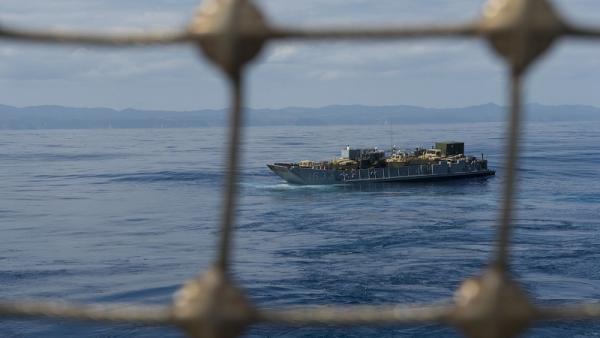Subduing China an empty gesture as Trump-shy Asia courts Beijing

Bob Carr, Director, Australia-China Relations Institute, University of Technology Sydney |
This article appeared in The Australian on May 30 2018.
Senator Jim Molan is blunt about something Australians can’t wish away: the shift in power in the South China Sea. The former senior army officer said: 'The Chinese will not be dislodged from the South China Sea short of all-out war.' Whether we conduct naval operations like those of the Americans is now irrelevant.
Another response is proving pretty irrelevant, too. That is the Quad, the name given to the mechanism set up last November between the US, India, Japan and Australia. The Quad had always been tentative, nothing more than a single meeting in the margins of the East Asia Summit.
Commentator Rory Medcalf called the Quad 'a symbol that the best hope of moderating a strong China’s behaviour involves others showing solidarity with each other'.
But six months on, the Quad has failed what was always going to be its acid test: harmonising policy towards China. From Australia’s perspective, this was confirmed with a dramatic gesture from India. Late last month India slammed the door on Australia joining the Malabar naval exercises, reportedly because India’s Narendra Modi was giving greater priority to the success of his April 27 meeting with Chinese President Xi Jinping. Modi wants a resilient bilateral relationship with China. He sees Donald Trump as protectionist — and perhaps Australia, at the moment, as a bit too rhetorically anti-China.
Japan has shown that the Quad won’t determine its China options. The bilateral meeting on May 8 between Japanese Prime Minister Shinzo Abe and Chinese Premier Li Keqiang was a signal Japan and China were relegating their territorial dispute in the East China Sea. Japan, too, is hit with Trump’s tariffs and worries at his unpredictability on North Korea.
On May 9 Japan participated in a trilateral summit with South Korea and China to explore options for the peninsula. Unlike the Quad meeting of last November, the three nations were represented by leaders, not second-level public servants.
A China-Japan rapprochement is under way. That one-hour meeting that launched the Quad won’t restrain Abe from exploring a better relationship with Beijing. Diplomacy in northeast Asia is fluid and the US is unpredictable.
Before Japan, Li had visited Indonesia. Only six days earlier, CNBC had broken the story that China had installed anti-ship cruise missiles on three outposts. Any Australian foreign minister would have had no alternative but to speak, as Julie Bishop did on May 4, expressing opposition to militarisation of the region. But the Indonesian President did not even mention China’s missiles. He did not raise them with the Chinese Premier.
The Quad and its implicit mission — to balance China — is not influencing Southeast Asians. In fact the 10 Association of Southeast Asian Nations states are pursuing their own engagement with China. The Philippines’ view of the militarisation of the South China Sea was summed up by Rodrigo Duterte, who said: 'Ignore the missiles there. They are not for us.' This did not change much when China landed long-range bombers on an airstrip in the South China Sea on May 17.
In Sydney in March, Singapore’s Lee Hsien Loong had expressed a cautionary note about the Quad, saying: 'We do not want to end up with rival blocs forming or countries having to take one side or the other.'
Some of the hopes invested in the Quad capture our neuralgia about being left alone in Asia. Witness how seriously some Australians took a stray comment from a US official in February that Quad countries might sponsor their own Belt and Road Initiative.
The BRI is by definition China exporting surplus infrastructure. When Shanghai is linked to Kunming by high-speed rail, the next step is high-speed rail into the northern ASEAN states; same with highways, pipelines and ports. India has no such surplus capacity and its voters probably would fling from office any government that said it would sponsor investment in the 'Stan' states instead of meeting the country’s own needs.
The US has the chronic infrastructure deficit of a failed state. The much-discussed upgrade of a rail link from San Francisco to Los Angeles may be completed in 2040. Against China’s 25,000km, the US can’t boast 1km of high-speed rail.
Of the Quad members, only Japan has the capacity to compete with China’s export of infrastructure. That competition — in Thailand and Indonesia, for example — will be serious and therefore beneficial all around.
I’ve previously said the Quad may be a warning to China about the cost of assertiveness in maritime disputes. But if Southeast Asians are indifferent, and if Japan and India are reinvigorating their China links, then the Quad looks little more than a gesture. I’m not pretending this is the happiest outcome for Australia. The Quad was never going to be an Asian NATO, but right now it lacks even the value of the modest hedge that I thought might have been within reach.
Author
Bob Carr is director of the Australia-China Relations Institute at the University of Technology Sydney. He is a former Australian foreign minister and was the longest serving premier of NSW.

